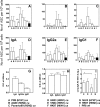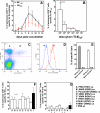The magnitude of local immunity in the lungs of mice induced by live attenuated influenza vaccines is determined by local viral replication and induction of cytokines
- PMID: 20962087
- PMCID: PMC3014215
- DOI: 10.1128/JVI.01564-10
The magnitude of local immunity in the lungs of mice induced by live attenuated influenza vaccines is determined by local viral replication and induction of cytokines
Abstract
While live attenuated influenza vaccines (LAIVs) have been shown to be efficacious and have been licensed for human use, the surface glycoproteins hemagglutinin (HA) and neuraminidase (NA) have to be updated for optimal protective efficacy. Little is known about the effect of different HA and NA proteins on the immunogenicity of LAIVs developed using the same backbone. A panel of LAIVs that share the internal protein genes, with unique HA and NA gene segments from different influenza subtypes, was rescued by reverse genetics, and a comparative study of immune responses induced by these vaccines was conducted in mice. The results suggest that the magnitude of lung immunity, including pulmonary IgA antibody and memory CD8(+) T lymphocytes, induced by the vaccines depends on the replication efficiency of the LAIVs, as well as the induction of cytokines/chemokines in the lungs. However, these factors are not important in determining systemic immunity such as serum antibody titers and memory CD8(+) T cells in the spleen. A qualitative analysis of immune responses induced by a single dose of an H5N1 LAIV revealed that the vaccine induced robust systemic and mucosal immunity in mice. In addition, antibodies and memory lymphocytes established in the lungs following vaccination were required for protection against lethal challenge with homologous and heterologous H5N1 viruses. Our results highlight the different requirements for inducing systemic and lung immunity that can be explored for the development of pulmonary immunity for protection against respiratory pathogens.
Figures







Similar articles
-
Characterization of reverse genetics-derived cold-adapted master donor virus A/Leningrad/134/17/57 (H2N2) and reassortants with H5N1 surface genes in a mouse model.Clin Vaccine Immunol. 2014 May;21(5):722-31. doi: 10.1128/CVI.00819-13. Epub 2014 Mar 19. Clin Vaccine Immunol. 2014. PMID: 24648485 Free PMC article.
-
Live-attenuated pandemic H1N1 influenza vaccines expressing computationally optimized broadly reactive antigens (COBRAs) are immunogenic and protective in mice and ferrets.Vaccine. 2025 Apr 19;53:127090. doi: 10.1016/j.vaccine.2025.127090. Epub 2025 Apr 4. Vaccine. 2025. PMID: 40186991
-
Live attenuated H5N1 vaccine with H9N2 internal genes protects chickens from infections by both highly pathogenic H5N1 and H9N2 influenza viruses.Influenza Other Respir Viruses. 2013 Mar;7(2):120-31. doi: 10.1111/j.1750-2659.2012.00363.x. Epub 2012 Apr 9. Influenza Other Respir Viruses. 2013. PMID: 22487301 Free PMC article.
-
Development of live-attenuated influenza vaccines against outbreaks of H5N1 influenza.Viruses. 2012 Dec 10;4(12):3589-605. doi: 10.3390/v4123589. Viruses. 2012. PMID: 23223214 Free PMC article. Review.
-
Live Attenuated Cold-Adapted Influenza Vaccines.Cold Spring Harb Perspect Med. 2021 Sep 1;11(9):a038653. doi: 10.1101/cshperspect.a038653. Cold Spring Harb Perspect Med. 2021. PMID: 32253347 Free PMC article. Review.
Cited by
-
[Composition and mode of action of adjuvants in licensed viral vaccines].Bundesgesundheitsblatt Gesundheitsforschung Gesundheitsschutz. 2019 Apr;62(4):462-471. doi: 10.1007/s00103-019-02921-1. Bundesgesundheitsblatt Gesundheitsforschung Gesundheitsschutz. 2019. PMID: 30830257 Review. German.
-
Viral vectored vaccines: design, development, preventive and therapeutic applications in human diseases.Signal Transduct Target Ther. 2023 Apr 7;8(1):149. doi: 10.1038/s41392-023-01408-5. Signal Transduct Target Ther. 2023. PMID: 37029123 Free PMC article. Review.
-
Induction of protective immunity against influenza A/Jiangxi-Donghu/346/2013 (H10N8) in mice.J Gen Virol. 2017 Feb;98(2):155-165. doi: 10.1099/jgv.0.000683. Epub 2017 Mar 13. J Gen Virol. 2017. PMID: 27983474 Free PMC article.
-
Distribution of Droplets and Immune Responses After Aerosol and Intra-Nasal Delivery of Influenza Virus to the Respiratory Tract of Pigs.Front Immunol. 2020 Oct 27;11:594470. doi: 10.3389/fimmu.2020.594470. eCollection 2020. Front Immunol. 2020. PMID: 33193445 Free PMC article.
-
Antigen-activated dendritic cells ameliorate influenza A infections.J Clin Invest. 2013 Jul;123(7):2850-61. doi: 10.1172/JCI67550. Epub 2013 Jun 24. J Clin Invest. 2013. PMID: 23934125 Free PMC article.
References
-
- Block, S. L., R. Yogev, F. G. Hayden, C. S. Ambrose, W. Zeng, and R. E. Walker. 2008. Shedding and immunogenicity of live attenuated influenza vaccine virus in subjects 5-49 years of age. Vaccine 26:4940-4946. - PubMed
Publication types
MeSH terms
Substances
Grants and funding
LinkOut - more resources
Full Text Sources
Medical
Research Materials
Miscellaneous

